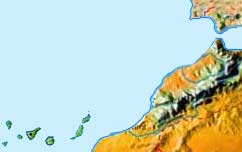Canary Islands, forgotten for a millennium?
deutsch english español françaisBerlin · 2007 Uwe
Topper ![]()

The Canary Islands as instance for a missing chronological link of one thousand years The Institutum Canarium (Austria) has studied the history of the Canary Islands for the last thirty years and publishes in its annual „Almogaren“ its findings. Recently there appeared an article by Pablo Atoche Peña (University of Las Palmas of Gran Canaria) entitled „Canarias en la Fase Romana (circa s.I a.n.e. al s. III d.n.e.): los hallazgos arqueológicos“ (vol. XXXVII/2006, p.85-117) which the author had given as lecture at the yearly meeting in Las Palmas (Gran Canaria) in Mai 2005.
Atoche Peña recalls that the early contacts of Europeans or Africans with the Canary Islands and their inhabitants are documented from phenician time onwards, followed by those of the Carthaginians and finally by the Romans until the 3rd century AD.
He also makes clear that even most primitve seafaring people could reach the islands from the coast of Africa, e.g. from Mogador or Cape Juby, and that even Cádiz at the tip of the Iberian Peninsula was not to far away to sail from there to La Palma, the northwestern island, as rock carvings and archaeological finds testify.
The contacts of these three cultural groups stretch over a bit more than thousand years after which an equally long phase of no visitors envolves the Islands in fog. After that (at the end of the 14th century) starts the conquest of the Islands by Christians, mostly Spaniards and allied nations who not only traded and missioned there but destroyed the aboriginal culture and assimilated the inhabitants.
At this point I shall leave common knowledge and start my question: Could it really be that the Canaries were forgotten by sailors or despised by traders during a whole millennium? Rare pigments like purpure of the dragon tree could have tempted them like it did those of antiquity. And the knowledge of the existence of these islands was never lost, Latin texts refered to them all the time. As it had been easy to reach the Canaries in Phenician time, Arabs or Wikings would easily have done the same.
We could suppose a catastrophy that wiped out all knowledge. Yet after a very short time the contact to the islands would have been renewed because from tops of the High Atlas near the coast of West Africa one could see with good atmospheric conditions the clouds that gather around Pic Teide of Tenerifa, and any experienced sailor would immediately know that he could expect a large island there. To the easternmost islands Fuerteventura and Lanzarote some fishing boats are deviated by storm off and on until now, and they easily find their way back to the African coast when the storm has ceased.
If someone had discovered the islands accidentally that way, the knowledge would have spread like a fire in no time. In short: The Canary Islands couldn’t hide from well or bad willing seafarers for thousand years.
There is another hint to the conclusion that the hiatus has no real foundation but is artificially provoked by wrong chronology: When the first amphoras were found on the Canary Islands they were classed by scientists as Roman, and more exactly as late imperial. The eminent Prof. Miguel Beltrán himself had proposed the classification of the amphoras in 1970 but twenty years later (1990, p.91. note 14) he had to confess that this was an error; the amphoras were not antique Roman but belonged to the 16th Christian century and thereafter. It is not easy to admit an error of such a consequence, so the correction has its full weight.
The same error had been committed by archaeologists who classified amphoras as Roman found at the coast of South America but later had to recall this astonishing announcement and come down to the 16th century with provenance Granada and Almeria in Southern Spain.
Errors of this magnitude are quite telling. As it seems amphoras for oil or wine from Roman workshops of imperial time and amphoras from Christian 16th century Spain are with all their marks and details so much equal that experts have difficulty in telling the difference. Then there cannot have passed more than a generation or two between their manufacture because a handicraft like pottery cannot slumber for one millennium and than be resuscitated in exactly the same way. The direct passing on of the knowhow from father to son is a basic condition.
So the Canary Islands at the westernmost edge of the oecumene give us two indications for our thesis that Christian chronology might be wrong by as much as a thousand years. There could be other factors underlying the problem – such as a catastrophy – but the solution (aided by a lot of indications all over the old world) seems now very simple: Late imperial Roman time and early Christian Spanish seafaring follow closely each other. The traditional millennium between them is due to the chronological invention of the church.
Originally written in German. Translated by the author, Uwe Topper, July 2009
![]() I would like to write a comment to this text:
I would like to write a comment to this text: